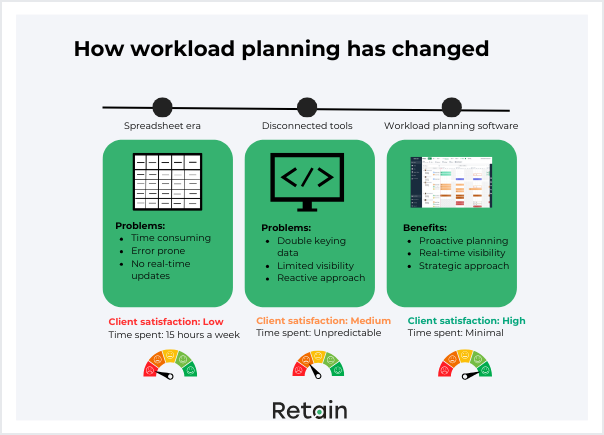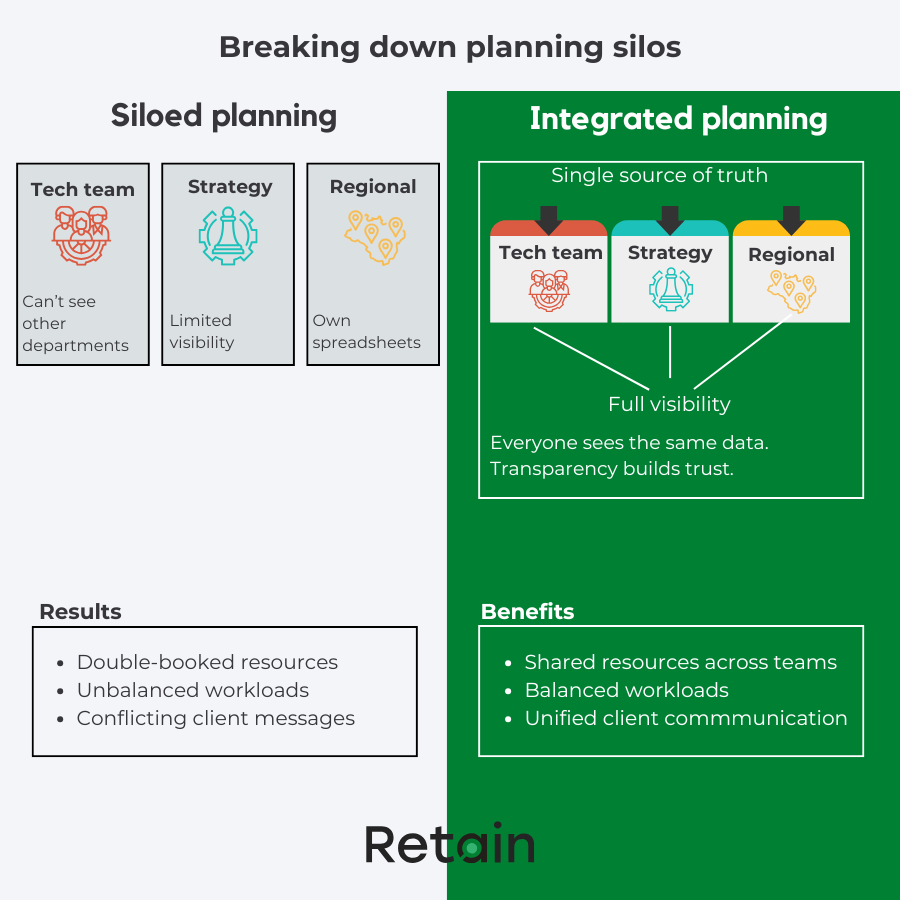If you've ever found yourself drowning in spreadsheets, trying to figure out who's actually available for next week's client project, you're not alone. Workload planning is deceptively tricky.
The good news? You can move beyond basic scheduling tactics to something more sophisticated without adding complexity to your day. Let's explore some practical strategies that transform how you manage your team's capacity and capabilities.
How workload planning has changed
Remember mapping out projects with coloured sticky notes on a whiteboard? Or perhaps you're still wrestling with that unwieldy Excel template someone created years ago.
For many businesses, workload planning hasn't evolved much beyond these manual methods. It's often reactive - someone shouts that they're overloaded, and suddenly you're shuffling tasks around to prevent a crisis.

This approach might work when things are quiet, but it falls apart quickly when demand increases. Projects get delayed because the right people aren't available at the right time. Team members become frustrated with constant priority shifts. Client satisfaction drops when deadlines are missed.
What's interesting is how much time organisations spend managing workloads without actually improving their approach. One resource manager we spoke to estimated she spent 15 hours weekly updating spreadsheets - that's nearly two full working days just maintaining the system!
Key elements of smart workload planning
So what makes workload planning "smart" rather than just basic scheduling? Here are the key elements you need:

#1. Real-time visibility
When you can actually see what everyone is working on right now (not what was recorded last week), decision-making improves dramatically. A project manager at a digital agency told me they cut their weekly planning meetings from two hours to 15 minutes once they had live data at their fingertips.
#2. Skills-based matching
Having someone available doesn't mean they're the right fit. Smart workload planning considers capabilities alongside capacity. This means you find the person whose skills and experience best match the task, not just whoever happens to be free.
#3. Forward-looking forecasting
Forecasting gives you breathing room. Instead of constantly putting out fires, you can spot potential resource crunches weeks in advance and address them calmly. A resource planner at a leading consultancy firm recently told us: "The biggest shift for us wasn't the tool itself, but moving from thinking about tomorrow to thinking about next month. That mental shift changed everything."
#4. Balanced utilisation
Smart workload management finds the sweet spot between underutilisation (wasting capacity) and overutilisation (burning people out). It recognises that sustainable productivity hovers around 75-85% utilisation for most knowledge workers, not 90-100%.
#5. Cross-team coordination
Breaking down silos between departments means resources can be shared efficiently. One operations director confessed: "We used to have the bizarre situation where we were hiring contractors in one department while another had bench time. Now we can see and share capacity across teams."
#6. Scenario planning
What happens if that big project gets delayed? What if we win two major bids in the same month? Smart workload planning lets you model different scenarios and prepare contingency plans rather than being caught off guard.
When your workload management runs smoothly, something interesting happens. You'll find yourself with mental space to think strategically about your resources and how they create value. Many managers tell us this shift from reactive to proactive thinking was the biggest benefit they experienced.
Looking beyond availability
The most basic workload management tools only show you who's free and who's not. That's helpful, but you might miss better options just because they require a bit more searching.
Your team members bring unique combinations of skills, experience and knowledge. Smart workload planning taps into these differences.
Start by documenting what your people are actually good at. This doesn't need to be complicated - even a simple skills matrix can transform your planning approach. Note technical abilities, sector experience, client relationships, certifications, and even development goals.
This approach can hugely help team performance. Many organisations find themselves assigning their best technical people to client-facing work simply because they have capacity, not because it's the right fit. These technical specialists often find client interactions draining, while other team members might excel at client management but are overlooked.
When you match people to their strengths, everything improves. Project outcomes get better because people are doing what they're good at. Team satisfaction increases because people enjoy tasks that align with their natural abilities. And surprisingly often, profit margins improve too - work gets done more efficiently with fewer errors and revisions.
Using tools that incorporate skills data helps you make these matches more consistently. You'll deliver better work while also giving people tasks they genuinely enjoy.
Read more: Behavioural skills vs technical skills: why resource planning needs both
Know tomorrow's workload planning demands
Imagine knowing in July that you'll need three more developers in October. That's the power of capacity forecasting - it gives you time to prepare rather than scramble.
Basic workload planning only deals with what's confirmed right now. Smart planning includes what's likely coming up.
There's a finance director I know who transformed his consulting firm's profitability with this approach.
"We used to take on every project that came through the door, then figure out how to deliver it. Now we model different scenarios for incoming work against our capacity forecasts. Sometimes we say no, sometimes we adjust timelines, sometimes we bring in specialists. But we never just hope it will work out somehow."
Good workload management tools, like Retain, include forecasting features that help you visualise future demand. This transforms resource planning from reactive panic to strategic thinking.
You know that feeling when a major client approaches with an urgent project, and you're already stretched thin? With workload forecasting, you can confidently discuss realistic timelines based on actual capacity, not optimistic guesswork.
Break down planning silos
In many professional services firms, each department manages their own resources independently. Technical teams don't know what strategy teams are working on. Regional offices can't see what's happening at headquarters. This siloed approach is surprisingly common.

The results are predictably chaotic. People end up double-booked on multiple projects. Some teams struggle with overwhelming workloads while others have unused capacity. Clients receive conflicting messages about resource availability. Everyone feels frustrated, yet the solution is straightforward.
Advanced workload planning breaks down these silos by providing a single source of truth. When everyone can see the same data, planning becomes more effective and less stressful.
The impact of transparency is often unexpected. Team leaders who previously guarded their resources fiercely — afraid their people would be overcommitted — typically become more collaborative once they can see exactly what's happening across the organisation. The visibility creates trust that wasn't possible before.
With integrated workload management tools, you gain clear visibility across teams and locations. Resources can be shared when needed, skills gaps become obvious, and workload begins to balance more naturally. The organisation becomes more adaptable, responsive and unified in its approach to client work.
Many firms report that this transparency alone — before implementing any other process improvements — significantly reduces resource conflicts and improves utilisation rates. It's often the first and most impactful step in transforming resource management.
Get ahead of resource challenges
There's something oddly satisfying about putting out fires at work - solving urgent problems gives us a quick dopamine hit. But constantly operating in crisis mode is exhausting and inefficient.
Smart workload planning helps you spot issues before they become emergencies. You'll notice patterns like:
"Our UX designers are always booked solid three months in advance." "We struggle with capacity every January when everyone takes holiday time." "Client implementation projects consistently take 20% longer than we estimate."
Once you recognise these patterns, you can address them strategically. Perhaps you need to develop more UX capabilities within your team. Maybe you should plan lighter workloads for January. Or you might need to adjust how you scope implementation projects.
So, instead of constantly responding to immediate problems, you can identify recurring patterns and address underlying causes.
Make data-driven decisions

Have you ever had that nagging feeling that someone on your team is constantly overloaded while others seem to coast? Without good resource data, these impressions can lead to unfair judgments and poor decisions.
The right workload planning software gives you objective information about how work is actually distributed. You might discover surprising insights:
Your seemingly "lazy" team member actually handles twice as many support requests as anyone else. Your "superstar" consultant is consistently booked at 150% capacity, risking burnout and errors. Certain types of projects always require more resources than initially planned.
Data often reveals surprising insights that challenge our assumptions about resource allocation. Many organisations discover that what they perceived as inefficiency is actually something quite different. For instance, some firms find that senior team members who seemed to be spending too much time on non-billable work are actually not dedicating enough time to critical activities like mentoring. Good workload management tools provide these objective insights, helping you make decisions based on actual patterns rather than impressions or assumptions.
Avoid common workload planning pitfalls
Even with the best intentions, workload planning can quickly go off track. Here are the red flags to watch for in your planning process:
🚩 Over-optimism bias
We all want to believe we can fit in just one more project or complete tasks faster than reality allows. Smart workload planning balances ambition with honest capacity assessment.
🚩 Ignoring the human element
People aren't machines - they need variety, development opportunities, and reasonable workloads to perform at their best. Your workload planner should help you create sustainable schedules, not just maximise utilisation.
🚩 Fixation on billable hours
Focusing only on billable work is tempting but short-sighted. Development time, knowledge sharing, and innovation work might not generate immediate revenue, but they're essential for long-term success.
🚩 Unrealistic utilisation targets
Many organisations aim for extremely high utilisation rates that simply aren't sustainable. Research shows that knowledge workers perform best at around 75-80% utilisation, with the remaining time needed for learning, collaboration, and creative thinking.
🚩 Resistance to adjusting plans
When reality doesn't match your plan, the plan needs to change—not the other way around. Effective workload planning requires flexibility and regular reassessment.
Recognising these pitfalls is the first step toward avoiding them. By creating more realistic plans that account for human factors and long-term needs, you'll build a more sustainable and effective resource management approach.
Go beyond basic workload planning with Retain
Smart workload planning goes far beyond basic scheduling. It's about matching the right skills to the right projects, anticipating future needs, breaking down organisational silos, getting ahead of problems, and using data to guide decisions.
The right tools to manage workload can transform this process from a frustrating time-sink into a strategic advantage for your business. Whether you're managing a small team or coordinating resources across multiple locations, these approaches will help you work smarter, not harder.
Interestingly, the businesses that handle workload planning most effectively rarely talk about it as a separate activity - it's simply woven into how they operate daily. That's the ultimate goal: making smart resource management so natural that it becomes invisible.
Ready to take your workload planning beyond the basics, book a demo today? We'd love to hear about your challenges and share how other organisations are solving them.

